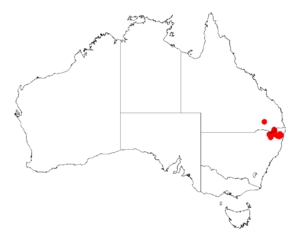Rupp's wattle facts for kids
Quick facts for kids Rupp's wattle |
|
|---|---|
| Conservation status | |
| Scientific classification | |
| Genus: |
Acacia
|
| Species: |
ruppii
|
 |
|
| Where Rupp's wattle grows in Australia | |
Acacia ruppii, commonly known as Rupp's wattle, is a special kind of shrub. It belongs to a big family of plants called Acacia or wattles. You can find this plant growing naturally in eastern Australia. Sadly, Rupp's wattle is listed as an endangered species under a law called the Environment Protection and Biodiversity Conservation Act 1999. This means it's very important to protect it so it doesn't disappear.
Contents
What Does Rupp's Wattle Look Like?
This shrub usually grows to be about 0.5 to 3 meters (1.5 to 10 feet) tall. It often looks like an open, bushy plant. Its branches are a bit hairy.
Leaves and Flowers
Rupp's wattle has unique "leaves" called phyllodes. These are actually flattened leaf stems that look and act like leaves. They are crowded together and are green. Each phyllode is flat and can be 8 to 22 millimeters long and 1 to 2 millimeters wide. They have a clear line down the middle.
The plant blooms between July and September. It produces small, round flower-heads that are 7 to 9 millimeters wide. These flower-heads are golden in color and each one can have 25 to 50 tiny flowers.
Seed Pods and Seeds
After the flowers bloom, dark brown or blackish seed pods grow. These pods are tough and can be straight or a bit curved. They can grow up to 8 centimeters long and are 4 to 7 millimeters wide. The pods can be smooth or slightly hairy.
Inside the pods, you'll find shiny black seeds. The seeds are shaped like an oval and are about 4 to 5 millimeters long. Each seed has a small, club-shaped attachment called an aril.
Where Does Rupp's Wattle Grow?
Rupp's wattle is an endemic plant, which means it only grows naturally in a specific area. It is found in a scattered way across a large part of eastern Australia.
Specific Locations
You can find it from the southeastern part of Queensland, near a place called Wyberba. It also grows south into New South Wales, around Torrington. In these areas, it often grows on high flat lands called tablelands. It prefers sandy soils that come from granite rocks. It's usually part of open scrub or woodland areas.
Rupp's wattle is also found in lower areas, like the hills between Coaldale and Grafton in New South Wales. In these spots, it grows in soils that come from sandstone.


